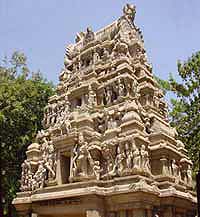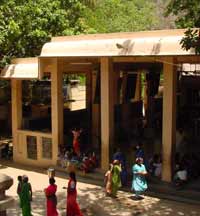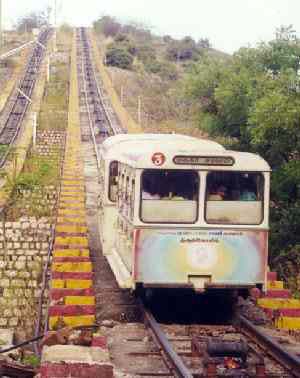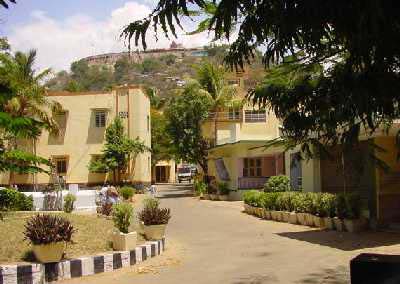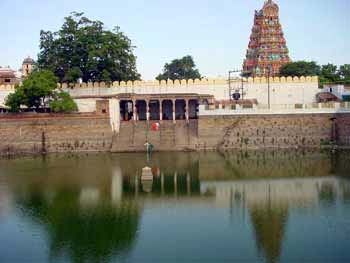Lord Murugan is the deity of the Tamil Land. Palani (Tiru Avinankudi) is the third Padai Veedu.
The temple at Palani is an ancient one, situated at an elevation of
1500 feet above sea level. The deity of Palani is known as
Dandayudhapani Swami, the Lord having the Staff in his Hand. The deity
at the sanctum sanctorum is made out of an amalgam of nine minerals popularly called Navabashana.
The deity is in a standing position with a baton in his hand. He has
the look of a person who has renounced all worldly pomp. He has just a
loincloth besides the baton. He is a mute messenger of the great precept
'Renounce all to reach Me'. The icon is unique in the whole world. It
was made by siddha Bhogar by combining nine poisonous substances (navabashana). Murugan signifies beauty and Lord Murugan of Kurinji land is the god of Beauty and Youth.
The Legendary, Historical and Spiritual Significance of the Hill Temple
There
is a legend how Lord Murugan came to this sacred spot. Narada Muni, a
sage, brought a golden mango to the divine court of Lord Siva when Lord
Siva was seated with his consort Parvati and His children Lord Vinayakar
and Lord Subrahmanya. Narada gave the fruit to Lord Siva and implored
Him to eat since it was a rare, miraculous Jñanapalam, the fruit
of wisdom. As a loving husband, Lord Siva gave it to Parvati and
requested her to eat. As a loving mother, she wanted to give the fruit
to her children. As there was only one fruit and it should not be cut,
they announced a contest and said that the winner would be given the
fruit. Whoever completes one round of the globe first will be given the
fruit.
Lord Subrahmanya mounted His peacock to go around the
world. Lord Vinayakar circumambulated around His parents, symbolising
the world, and got the fruit. On return, Lord Subrahmanya found that He
was cheated. In anger, He renounced His family and came to this spot to
settle forever. Lord Siva and Parvati came to pacify Him. They said, "Pazham Nee" ('You are the Fruit'). Hence the name Palani is a popular syncopation of the two words mentioned.
The presiding deity, Lord Dandayudhapani Swami, is the son of Lord Siva and son-in-law of Vishnu. He has other names such as Kulandaivelan,
Balasubrahmanyan, Shanmukhan, Devasenapati, Swaminathan, Vallimanalan,
Devayanaimanalan, Palaniandavar, Kuriñjiandavar, Arumugan, Jñana
Pandita, Saravanan, Sevar Kodiyon, etc. Tamils, Keralites, Bengalis,
Sri Lankans, Malaysians, Fijians, Africans, Australians and Americans
to name a few come here to worship Lord Muruga. Thus Murugan worship
cuts across provincial boundaries and national frontiers.
Cheaman Perumal, a ruler of Kerala, built the main temple perhaps
in the 7th Century AD. The Nayaks built the Navaranga Mandapam which is
a fascinating stone structure incorporated by four pillars and endowed
with nine bays. The other portions of the temple have been built by the
Pandiya kings, besides a number of local heads, religious groups and
individual devotees.
Pujas
There are six pujas every day. At 5 am the Lord gives Visvarupa Darshana. The first puja is Vizhapuja at 7:15 am followed by Kala sandhi at 8am, Uchikalam at 12 noon, Sayaraksha at 6 pm and Rakkalam at 8 pm.
Golden Chariot
The Golden Chariot goes round the praharam on the top of the hill in a ceremonious procession along with nadaswaram, Tiruppukazh
music and other temple paraphenalia at 7 pm on all Karttikai days and
as per the request of the devotees. The illuminated Golden Car is a
veritable fairyland.
Festivals
Panguniuttiram, Thai Pucam, Kanda Sasthi, Agni Nakshatram are the major festivals. Vaikasi Vishakam, Tirukkarttikai and other festivals are also celebrated.
Kavadi & Pada Yatra
Bhogar Shrine
The Bhogar Shrine is in the southwestern
corridor of the hill temple. Siddhar Bhogar created the icon (the
amalgam of nine minerals) and did daily services. He lived long ago,
perhaps 3000 BC. A medical prodigy as he was, he could prepare the
amalgam on nine medicinal minerals in proper proportion. In this shrine,
pujas are offered to Navadurga, Bhuvaneswari and Maragatha Lingam that
were worshipped by Bhogar. It is said that there is a subterranean
tunnel linking the shrine with the sanctum sanctorum through which
Bhogar is said to go to the main idol and perform daily pujas as he is
said to be only in nirvikalpa samadhi.
Pañchamirtam & Rakkala Sandanam
Lord Muruga is Abhisekapriya
(fond of anointment), especially Pañchamirta (fruit jam having
medicinal properties). The Devasthanam prepares pañchamirta, vibhuti and
other items which are sold for reasonable price. Like Pañchamirta, the
Rakkala Sandanam (sandal paste placed on the deity during
To climb the hill, there are also winch trolleys in addition to the traditional route of 697 steps.
The Hundial
The
Hundial is the cash collection box. It is the backbone of the economy
of the temple. Palani Dandayudhapani Swami Devasthanam has the honour of
being the temple of highest income in Tamil Nadu and second only in all
India after Tirupati. 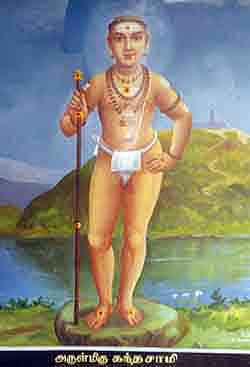
Annadanam (Offering meals to poor pilgrims)
Giving annadanam
at the hill temple at 12:30 pm is a useful scheme for the benefit of
the devotees. If a donor deposits Rs 25,000, the interest of it will be
utilised for annadanam on a particular day as per the request of the donor.
Tonsure Ceremony
Tonsure ceremony is a special feature of Palani. Many devotees of all ages perform tonsure ceremony at Palani.
Constituent Temples
Tiruvavinankudi,
Periyanagaki Amman temple, Shanmuganadhi group of temples, Idumban
Hills, Vishnu temple, Pada Vinayagar temple, 108 Vinayagar shrines
around the hill temple, the Kuriñjiandawar temple (Kodaikkanal), the
Velappar temple aat Poomparai (Kodaikkanal) are the important
constituent temples adminstered by Palani Dandayudhapani Swami
Devasthanam.
Management
This temple is under the control of the Hindu Religious and
Charitable Endowments Department of the Government of Tamil Nadu. There
is a Joint Commissioner/Executive Officer to look after the day-to-day
administration of Palani temples. He works in close association with the
Chairman, Board of Trustees and other members.
Accommodation
The
Devasthanam has constructed pilgrims' resthouses, single, double, deluxe
and air-conditioned rooms as well as cottages. Reasonable rates are
collected from the devotees.
Transportation
Palani is
reached by just three hours drive from any of the nearest airports:
Coimbatore, Madurai and Tiruchy. It is an important railway station on
the Dindugal-Coimbatore line. The nearest tourist information office is
at Madurai. There is a Palani Devasthanam Information Centre at the
Palani bus stand.
|
|
|
Devasthanam pilgrim accommodation: "Dandayudhapani Nilaiyam"
|
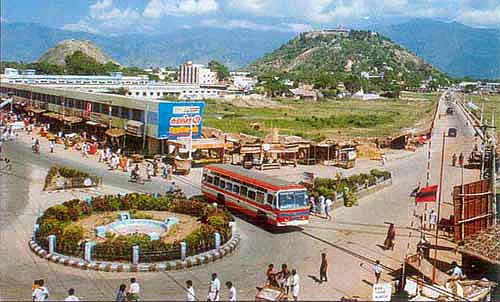 |
|
View of Palani Malai from Palani town centre
|
Shopping
Panchamirtam, vibhuti, souvenirs of
Murugan, toys, handicrafts, pictures of the Lord and publications of the
Devasthanam are among the souvenirs one can bring home from Palani.
